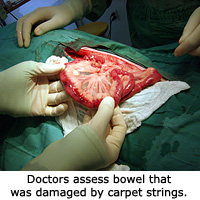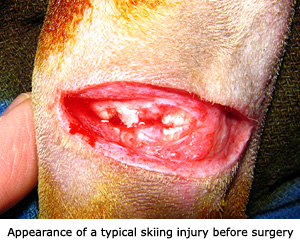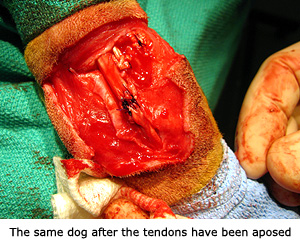| |
|
Emergency
Surgery
When emergencies
happen, Pet Kare Clinic is ready to help. We have a 24 hour on call
staff of doctors and technicians with full diagnostics available. Our
doctors and after hours staff are well equiped to handle most any surgical
emergency.
The 3 most
common life-threatening surgical emergencies we see regularly:
- Gastric
Dilitation Volvulus (GDV, aka bloat) - Client
Handout on GDV
- GDV
is the mother of all emergencies because the stomach has twisted
upon itself, squeezing off the blood supply to the stomach and
possibly spleen. If the surgery is not performed within minutes
the patient will die.
- The
patient usually presents with a distended abdomen, difficulty
breathing, pale mucous membranes, and a rapid heartbeat. Many
times the dog is "trying to vomit". The stomach becomes
distended and then torsion occurs.
- GDV
occurs most frequently in deep-chested dogs: (Great Danes, St.
Bernards, Weimaraners, Akitas, Standard Poodles, Malamutes, Irish
Setters, etc. If you have one of these breeds, or another dog
who has a very thin deep chest, a prophylactic gastropexy can
be performed to prevent occurance. We can now perform the gastropexy
through minimally invasive surgery (laparoscopy)
at the time of spay or neuter.
 Foreign
Body Obstruction (object
stuck somewhere in the GI tract) Foreign
Body Obstruction (object
stuck somewhere in the GI tract)
- Dogs
and cats often eat strange things and when these objects cannot
pass through the intestines safely they need to be surgically
removed.
- The
most common surgical foreign bodies are: corn cobs, sticks, underwear,
cloth, string, bones, and rocks.
- Splenectomy
(Hemoabdomen from a bleeding splenic tumor)
Client
Handout on Splenectomies
- Splenectomies
are usually emergencies due to the large amount of blood an animal
can loose into its abdomen from a ruptured spleen or splenic tumor.
 One
of the most common (usually not life-threatening) injuries that we see
at our clinic each winter are skiing injuries! Dogs skiing with their
owners, downhill or cross-country, often get an arm, leg or foot caught
under a ski's edge. Many times these injuries require extensive surgical
repairs due to deep tendon lacerations or transections. One
of the most common (usually not life-threatening) injuries that we see
at our clinic each winter are skiing injuries! Dogs skiing with their
owners, downhill or cross-country, often get an arm, leg or foot caught
under a ski's edge. Many times these injuries require extensive surgical
repairs due to deep tendon lacerations or transections.
If there
is tendon involvement the prognosis is often guarded and at a minimum
requires 6-8 weeks of immobilization, bandage changes and restricted
activity.
 Occasionally
we see arterial lacerations from skis that can be life-threatening.
The life of your dog may depend on the level of first aid they recieve
on the way to the hospital. Occasionally
we see arterial lacerations from skis that can be life-threatening.
The life of your dog may depend on the level of first aid they recieve
on the way to the hospital.
If your
dog has been cut and is bleeding apply direct pressure with a soft compressive
dressing and your fingers. DO NOT place a turniquet. Please get your
dog to the hospital as soon as possible and please don't place anything
into the wound (ie. no neosporin, hydrogen peroxide etc.)
|
|
|

 Foreign
Body Obstruction (object
stuck somewhere in the GI tract)
Foreign
Body Obstruction (object
stuck somewhere in the GI tract)
 One
of the most common (usually not life-threatening) injuries that we see
at our clinic each winter are skiing injuries! Dogs skiing with their
owners, downhill or cross-country, often get an arm, leg or foot caught
under a ski's edge. Many times these injuries require extensive surgical
repairs due to deep tendon lacerations or transections.
One
of the most common (usually not life-threatening) injuries that we see
at our clinic each winter are skiing injuries! Dogs skiing with their
owners, downhill or cross-country, often get an arm, leg or foot caught
under a ski's edge. Many times these injuries require extensive surgical
repairs due to deep tendon lacerations or transections.  Occasionally
we see arterial lacerations from skis that can be life-threatening.
The life of your dog may depend on the level of first aid they recieve
on the way to the hospital.
Occasionally
we see arterial lacerations from skis that can be life-threatening.
The life of your dog may depend on the level of first aid they recieve
on the way to the hospital.